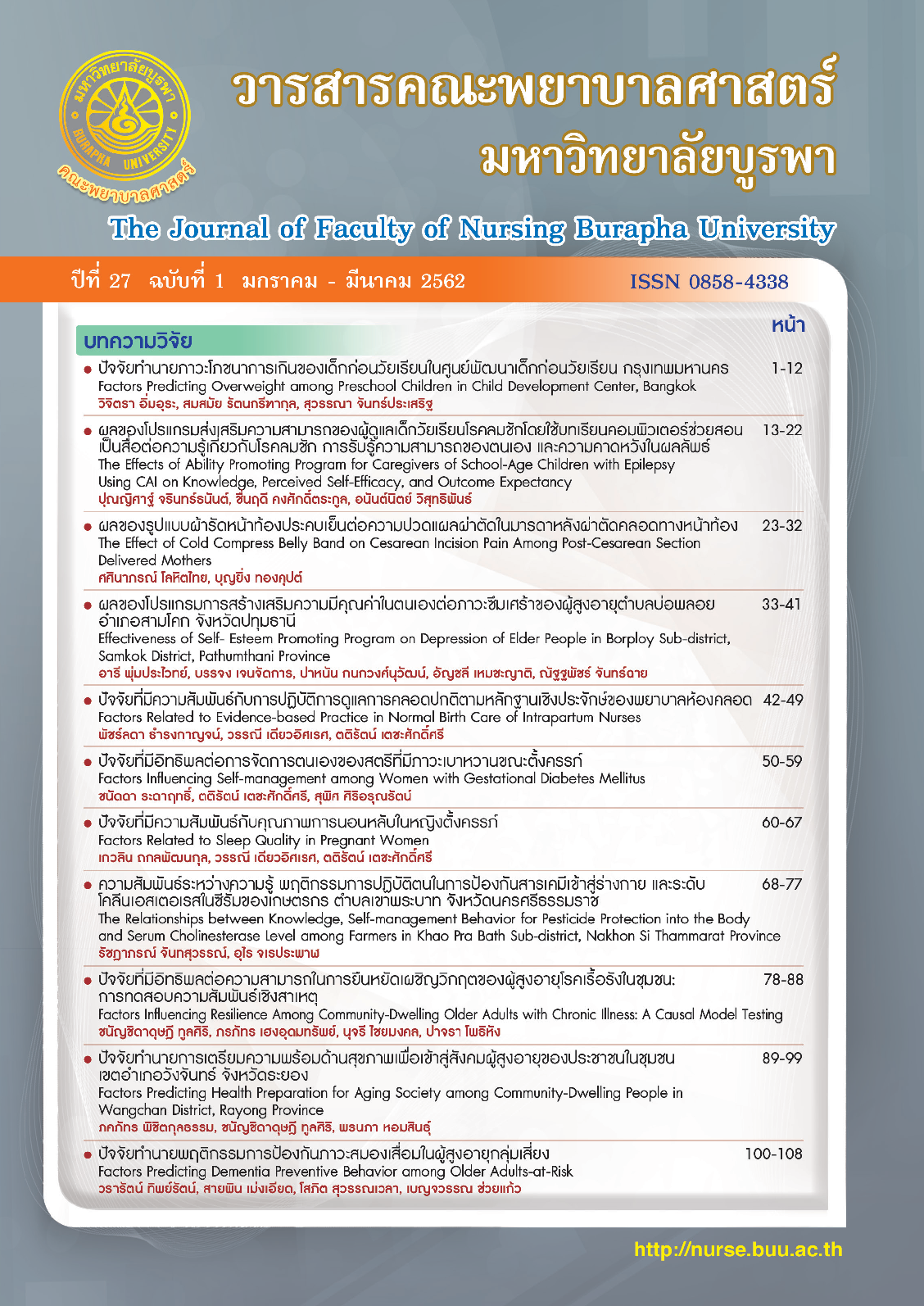ผลของโปรแกรมส่งเสริมความสามารถของผู้ดูแลเด็กวัยเรียนโรคลมชักโดยใช้บทเรียนคอมพิวเตอร์ช่วยสอนเป็นสื่อต่อความรู้เกี่ยวกับโรคลมชัก การรับรู้ความสามารถของตนเอง และความคาดหวังในผลลัพธ์
คำสำคัญ:
ผู้ดูแลเด็กโรคลมชัก, โปรแกรมส่งเสริมความสามารถ, ความรู้, การรับรู้ความสามารถของตนเอง, ผลลัพธ์ที่คาดหวังบทคัดย่อ
บทคัดย่อ
การวิจัยกึ่งทดลองครั้งนี้มีวัตถุประสงค์เพื่อศึกษาผลของโปรแกรมส่งเสริมความสามารถของผู้ดูแลในการดูแลเด็กวัยเรียนโรคลมชักโดยใช้บทเรียนคอมพิวเตอร์ช่วยสอนเป็นสื่อ กลุ่มตัวอย่างคัดเลือกแบบสะดวก ประกอบด้วยผู้ดูแลเด็กโรคลมชักอายุ 6-12 ปี ที่พาเด็กมารับการรักษาที่หน่วยตรวจผู้ป่วยเด็กนอก โรงพยาบาลระดับตติยภูมิ จังหวัดชลบุรี แบ่งเป็นกลุ่มควบคุมได้รับการดูแลตามปกติจำนวน 47 คน และกลุ่มทดลองได้รับโปรแกรมส่งเสริมความสามารถในการดูแลเด็กโรคลมชักร่วมกับการดูแลตามปกติจำนวน 48 คน เครื่องมือที่ใช้ในการวิจัย ได้แก่ แบบบันทึกข้อมูลทั่วไป แบบสอบถามความรู้เกี่ยวกับโรคลมชัก แบบวัดการรับรู้ความสามารถของตนเอง และแบบวัดความคาดหวังต่อผลลัพท์ของการรักษาและการจัดการอาการชัก วิเคราะห์ข้อมูลด้วยสถิติพรรณา การทดสอบแมนวิทนีย์ ยู และวิลคอกซัน
ผลการวิจัยพบว่า เมื่อสิ้นสุดการทดลอง กลุ่มทดลองมีคะแนนความรู้เกี่ยวกับโรคลมชัก การรับรู้ความสามารถของตนเอง ความคาดหวังต่อผลลัพท์ของการรักษา และความคาดหวังต่อผลลัพท์การจัดการอาการชัก มากกว่ากลุ่มควบคุมอย่างมีนัยสำคัญทางสถิติ (Z = -6.482, p<.05, Z = -3.847, p<.05, Z = -2.656, p<.05, Z = -2.549, p<.05 ตามลำดับ) ดังนั้นพยาบาลหรือผู้ที่เกี่ยวข้องควรนำโปรแกรมส่งเสริมความสามารถในการดูแลเด็กโรคลมชักไปใช้ เพื่อช่วยให้ผู้ดูแลมีความรู้เกี่ยวกับโรคลมชัก เพิ่มการรับรู้ความสามารถของตนเอง และมีความคาดหวังในผลลัพธ์ที่เหมาะสมในการดูแลเด็ก อันจะส่งผลให้เกิดพฤติกรรมการดูแลเด็กที่ถูกต้องเหมาะสมต่อไป
เอกสารอ้างอิง
Asawavichienjinda, T., Sitthi-Amorn, C., & Tanyanont, W. (2002). Prevalence of epilepsy in rural Thailand: a population-based study. Journal of the Medical Association of Thailand, 85(10), 1066-1073. [In Thai]
Bandura, A. (1997). Self-efficacy: The exercise of control. New York: W.H. Freeman.
DiIorio, C., Shafer, P., Letz, R., Henry, T., Schomer, D., & Yeager, K. (2003). The association of stigma with self-management and perceptions of health care among adults with epilepsy. Epilepsy and Behavior, 4(3), 259-267.
Freilinger, M., Reisel, B., Reiter, E., Zelenko, M., Hauser, E., & Seidl, R. (2006). Behavioral and emotional problems in children with epilepsy. Journal of child neurology, 21(11), 939-945.
Hayeese, W., Sap-In, N., Pichaisongkram, S., & Chaimongkol, N. (2016). Effects of the perceived self-efficacy promotion program of caregivers on quality of life of Muslim preterm infants in naradhiwas province. The Journal of Faculty of Nursing, Burapha University, 24(2), 51-60. [In Thai]
Information Technology Ramathibodi Hospital. (2017). The statistics of children with epilepsy at the pediatric outpatient department, Ramathibodi hospital. [In Thai]
Jantzen, S., Müller-Godeffroy, E., Hallfahrt-Krisl, T., Aksu, F., Püst, B., Kohl, B., & Thyen, U. (2009). FLIP&FLAP-A training programme for children and adolescents with epilepsy, and their parents. Seizure, 18(7), 478-486.
Kangwal, C., Kongsaktrakol, C., Maneesriwongul, W., & Visudtibhan, A. (2016). Factors Related to Medication Adherence among Children with Epilepsy. Ramathibodi Nursing Journal,
23(1), 44-59. [In Thai]
Kittivittayakul, P., & Chunhawiksit, W. (2008). The needs and related factors of caregivers when caring for epileptic children. Songklanagarind Medical Journal, 26(4), 339-347. [In Thai]
Kongsaktrakul, C., Jarintanan, P., Panjatharakul, P., & Visudtibhan, A., (2017). Research reports: The development of computer assisted instruction for caregivers of children with epilepsy. Ramathibodi School of Nursing, Faculty of Medicine Ramathibodi Hospital, Mahidol University. [In Thai]
Mayer, R. E. (2002). Cognitive Theory and the Design of Multimedia Instruction: An example of the two‐way street between cognition and instruction. New Directions for Teaching and Learning, 2002(89), 55-71.
Pfafflin, M., Petermann, F., Rau, J., & May, T. W. (2012). The psychoeducational program for children with epilepsy and their parents (FAMOSES): Results of a controlled pilot study and a survey of parent satisfaction over a five-year period. Epilepsy & Behavior, 25(1), 11-16.
Russ, S. A., Larson, K., & Halfon, N. (2012). A national profile of childhood epilepsy and seizure disorder. Pediatrics, 129(2), 256-264.
Saengsuwan, J., Boonyaleepan, S., Srijakkot, J., Sawanyawisuth, K., Tiamkao, S., & Integrated Epilepsy Research Group. (2012). Factors associated with knowledge and attitudes in persons with epilepsy. Epilepsy & Behavior, 24(1), 23-29.
Shafer, P. O., Buelow, J. M., Noe, K., Shinnar, R., Dewar, S., Levisohn, P. M., & Barkley, G. L. (2012). A consensus-based approach to patient safety in epilepsy monitoring units: recommendations for preferred practices. Epilepsy & Behavior, 25(3), 449-456.
Shore, C. P., Perkins, S. M., & Austin, J. K. (2008). The Seizures and Epilepsy Education (SEE) program for families of children with epilepsy: A preliminary study. Epilepsy & Behavior, 12(1), 157-164.
Songthip, S., Sanasuttipun, W., & Srichantaranit, A., (2015). The effects of supportive-educative nursing system program on knowledge and behaviors of mothers of children with acyanotic congenital heart disease aged 0-2 years. Thai Journal of Cardio-Thoracic Nursing, 26(2), 25-38. [In Thai]
Tanajaroenchananchai, R., Pongjaturawit, Y., & Chaimongkol, N. (2014). Effects of the perceived self-efficacy promotion program on maternal confidence to perform nasal irrigation for children with retained nasal secretion. The Journal of Faculty of Nursing, Burapha University, 22(2), 28-38. [In Thai]
Visudtibhan, A. (2011). Textbook for epilepsy in children. Bangkok: Olishing. [In Thai]
Wirrell, E., & Livingston, J. H. (2011). Epilepsy beginning in middle childhood. Childhood Epilepsy: Management from Diagnosis to Remission (pp. 29-72), Cambridge University Press.





